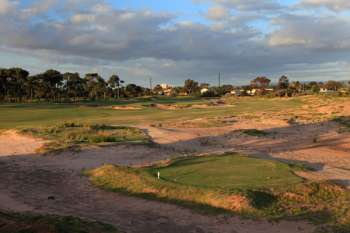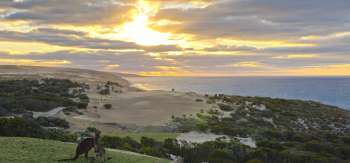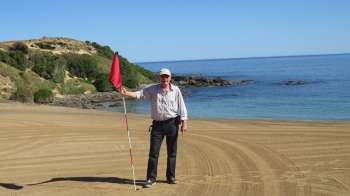What is happening at Royal Adelaide?
What on earth is happening at Royal Adelaide? It’s a question that members, guests and many on our Top 100 ranking panel have been asking for quite sometime now. Once entrenched within the Top 5 courses in this country, Royal Adelaide is presently a club divided, its golf course in the midst of what appears an uncertain, and protracted, identity crisis.
Unquestionably one of Australia’s finest golf clubs, the layout at Royal Adelaide has a unique history dating to its creation on the sandhills of Seaton back in 1905. It was originally designed by a couple of committee members, including the man who founded the nearby Kooyonga Golf Club. The course was then reshaped following the 1926 visit of legendary English architect Dr Alister MacKenzie. MacKenzie thought highly of the site at Seaton and wrote that, ‘no seaside course that I have seen possess such magnificent sand craters as those at Royal Adelaide.’ He added that if his plans were enacted the course would be, ‘superior to most, if not all, English championship courses.’
Part of today’s problem stems from the fact that the club decided against acting upon all of MacKenzie’s ideas. They did build his wondrous short par four 3rd hole, his much-loved sand crater drive at the 4th and his green site on the strong two-shot 14th, and later reshaped several other holes to reflect his views. Much of the course, however, remained the work of those earlier committeemen.
Apart from how sparse and sandy things were, what’s interesting to note about both the pre-and-post MacKenzie layouts at Royal Adelaide, is just how forgiving the landing areas were, especially considering the distances golf balls were hit back then. Much has changed in the ensuing decades. From the back tees today’s golf course, which stretches over 6,600 metres, is both narrow and penal, and rightly described by Michael Clayton as, ‘one of the toughest members tests in Australia.’
Clayton himself is the man at the centre of the club’s current malaise, having been engaged back in 2008 (prior to forming his partnership with Geoff Ogilvy) to create a Masterplan for course improvements. Previous architects Thomson, Wolveridge and Perrett had overseen the club’s modernisation, and transformed the once quasi-links into a more penal, parkland test. Clayton, like others, felt the course needed to return to its open, sandy roots and his Masterplan involved the expansion of several fairways and greens, the removal of a number of mounds and penal sand traps and a shift across the property to the more naturalistic bunkering style of earlier decades. Clayton’s Masterplan suggested, in essence, that Royal Adelaide should recapture the spirit of Dr. MacKenzie’s drawn plan and embrace, finally, his philosophies to make the course more strategic and more enjoyable for the vast majority to play.
Included as part of the course proposal, was a complete and radical redesign of the 17th hole, long regarded as among the poorest on the course. Clayton knew it was going to be a controversial hole to start with, but the board at the time decided to rebuild it first in order to prepare the membership for what lay ahead. That decision has been a disaster for the Masterplan, as the 17th is so dramatically out of character with the rest of the layout that it has become a lightning rod for disenfranchised members of the anti-Clayton camp, as well as those who saw no need to tinker with their beloved course in the first place.
A wide open par four with a large central bunker complex dividing the fairway, the hole itself is controversial for a number of reasons, chief among them being that it doesn’t really feel like it belongs at Royal Adelaide. This is certainly true at the moment, but only, as Clayton points out, ‘because we haven’t been able to implement more of what the plan is essentially about.’ Modelled on the MacKenzie drawing from 1926, the hole opened in early 2010 and has completely divided the membership. One member, Hugh Abbott, describes Clayton’s hole as ‘as a thing of beauty’, while another, former Captain David Cherry, lambasts it as an ‘expensive disaster’. Neither man was a fan of the previous version.
In terms of design, the main criticism of Clayton’s hole is that the central bunkers are too easy for good players to carry. While shorter hitters have to tack left or right around the hazards, the good players simply bomb over the top and leave themselves a short, and relatively simple, approach. Even fans of the hole concede the bunkers are too easy for A-graders to carry, although this seems to have been caused, at least partly, by the club’s reluctance to set the markers all the way to the back of the tee box.
Beyond the current impassioned debate around the success or otherwise of the new 17th hole, lies a philosophical argument brewing about the true nature of the Royal Adelaide golf course. It has become clear that internally the club needs to decide whether returning Seaton to something like its 1930s version would restore the lustre of the links or threaten to render it irrelevant and obsolete. According to David Cleland, the current Captain at Royal Adelaide, this is precisely what the present board is doing. Cleland notes that, ‘it was intended that we would construct one hole in accordance with the Masterplan and…depending on the views of members and the committee … either proceed with the next hole in the Masterplan or not proceed at all.’ He added that ‘while the members of the Committee have their own personal views on the 17th, they are waiting to see whether there is any consensus on the part of the members.’
Whether Ogilvy Clayton should be judged on the work of one controversial golf hole or not, when it comes to the new 17th at Royal Adelaide, consensus of opinion seems, at best, a pipedream. Members like Abbot, and 25-year veteran Chris Jamieson, love the hole, and want the club to enact the remainder of Clayton’s plan. In Jamieson’s view, ‘Clayton has some great ideas for the course and I just hope that members have faith and stay the course with the Masterplan.’ By contrast, David Cherry is dead against Ogilvy Clayton touching any further holes. In his opinion, apart from the new 17th hole, ‘the course is great.’ Another veteran member, Chris Redwood, agrees and says that he has, ‘perused the Masterplan and does not see the point in some of the proposed alterations.’ He adds that he, ‘would not support further use of this architect at Royal Adelaide.’
Cherry and Redwood’s comments reflect a reasonably wide held view that Royal Adelaide was fine the way it was, and only needed minor ‘touch-ups’ rather than dramatic cosmetic surgery. It’s why appeasing the entire membership with this radical new golf hole was always going to be next to impossible.
What is possible, and desperately needed at Royal Adelaide, is for the present board to show leadership and ambition and to outline clearly to both its constituents, as well as its consulting architects, precisely what the golf club represents. It does appear, from a distance, as though the goalposts have changed a little at Seaton over the past few years. Responding to a question on the club’s ultimate ambition, Captain David Cleland declared that it wanted to own ‘the best championship test possible,’ adding somewhat controversially that, ‘the comfort of the members on the course has always been secondary.’ Cleland points to the fact that Royal Adelaide has several forced carries and fewer lay-up areas for weaker hitters as evidence of its commitment to challenging quality golfers.
While true, this attitude muddies an already complex situation, as clearly returning to the character of the MacKenzie plan would open the course up further and likely make it much easier for the better golfer. Indeed, Clayton himself says in his detailed Masterplan document, ‘that there is not a single suggestion aimed at making the course more difficult. That is not, and should never be, a motivation of a committee or an architect.’ He says that his aim was not to make holes harder or easier, but just to make them better.
Interestingly, according to the very first line in the Masterplan, the club’s stated aim (at the time) was, ‘to see Royal Adelaide recognized as the best course in the country.’ As keen students of golf architecture are well aware, there can be an almighty chasm between wanting the ‘best course in the country’ and wanting the ‘best championship test possible,’ especially when it comes to such charming golf, and such quirky, undulating terrain.
There is no doubt that the current debate at Royal Adelaide is both a complex and emotional one. All members are fond of their golf course, and in the case of Seaton with very good reason. As the Ogilvy Clayton team have acknowledged in their Masterplan, it is not possible to simply recreate the MacKenzie plan for Royal Adelaide because the game has changed so much and many good improvements have been made to the course in the 85 years since he was on site. What they tried to do instead was inject some of his spirit into the layout, and to take direction from MacKenzie on any significant alterations needed. They did plan to rebuild the existing 1st hole with MacKenzie’s 1926 opener, which was located on the other side of the railroad track but never built. They also suggested rebunkering the strong par five 9th in line with his drawing, and to shorten holes like the 8th and 18th to introduce his preferred playing angles and strategies into the layout.
Whether Ogilvy Clayton will get the chance to continue with their Masterplan remains to be seen, with the club likely to make a decision in the coming months about whether to abort or embrace further fine-tuning. This decision will be based, in part, on the views of the membership and, in particular, those of the club’s A-graders. As Cleland confirms, ‘in line with the objective of being a championship course, we generally weight opinions more if they come from lower markers.’
So the immediate future of the Royal Adelaide golf course seems to be in the hands of Seaton’s single figure golfers, who will ultimately need to decide whether they prefer a tighter, less forgiving test of golf, or a layout that is more expansive and strategic. Should they reject Clayton’s plan it seems certain that the 17th will need to be rebuilt, and potentially another architect appointed. Royal Adelaide has fans across Australia and right around the world, many of whom will be watching developments there closely.
Darius Oliver, Architecture Editor
Back to NewsMore News
The Cliffs Kangaroo Island Announces Preview Play in early 2026
Major milestone for stunning new destination course with preview play available from January 2026
Who Really Designed Cape Wickham Links?
AGD ranks Cape Wickham #1 in Australia & interviews Duncan Andrews to get full story on course design
Cape Wickham Links – The Inside Design Story
Co-designer Darius Oliver reveals the truth behind the design of Australia’s premier modern golf course
2025 Karrie Webb Series scholars announced
Two young golfers set to follow in the footsteps of some of Australia's best golfers after winning 2025 scholarships





